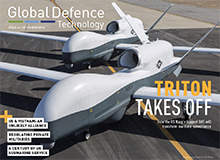
Over the last two decades, relations between the US and Vietnam have improved considerably and the two nations are now forging closer political, economic and military ties. We investigate how the geopolitical situation around the South China Sea and China’s recent aggression in territorial disputes have influenced the strategic thinking behind the two former enemies forming a new alliance.
Governments have increased their reliance on private military companies in recent conflicts but their use raises ethical questions – as illustrated by the high-profile trial of Blackwater guards involved in the Baghdad shootings of 2007. We explore the challenges of regulating private forces working alongside the military in conflict zones. We also find out what the US military is hoping to achieve with its open-source approach to new simulation technology development, take a look at the testing phase of Aeros’ massive military cargo airship and ask whether Textron AirLand’s Scorpion budget fighter jet can succeed on the international market.
Moreover, we review the capabilities of the US Navy’s Triton UAS as it gets ready to enter service alongside the manned Poseidon aircraft, chart landmark events in the Royal Navy’s 100-year history of Submarine Service on an interactive timeline and explore the Australian Government’s options as it chooses between domestic-built and Japanese-bought submarines.
In this issue
An Unlikely Alliance
Only forty years after their bitter conflict, the US and communist Vietnam are forging closer political, economic and military ties. Grant Turnbull investigates the strategic thinking behind his reconciliation.
Click here for the full article.
Shared Values
The US military is looking to use web-based technologies for simulation in an effort to increase collaboration and harness the potential of developers outside the defence industry. Grant Turnbull explores the benefits of the open-source approach.
Click here for the full article.
Straining Hearts and Minds
Governments often recruit private military and security companies to bolster regular troops and support services, but their use can raise ethical questions. Berenice Baker finds out more.
Click here for the full article.
Dreaming Big
Worldwide Aeros promises to revolutionise military heavy-lift operations with its massive Aeroscraft cargo airships, having proven the concept with the flight of a half-scale demonstration model. Berenice Baker asks whether a planned fleet of 22 airships for joint military and civil applications will take to the skies.
Click here for the full article.
Year of the Scorpion
Since its first flight in 2013, Textron AirLand’s new Scorpion aircraft has enjoyed significant attention from industry, the media and military top brass. Grant Turnbull asks, can the low-budget fighter jet live up to the hype and secure orders?
Click here for the full article.
Poseidon’s Perfect Partner
Northrop Grumman is developing the MQ-4C Triton for the US Navy to provide long-endurance maritime surveillance. Berenice Baker finds out how the navy’s biggest UAS ever will fly missions of up to 24 hours and work together with the manned Boeing P-8 Poseidon.
Click here for the full article.
A Century Unseen
The Royal Navy recently celebrated the 100th anniversary of the Submarine Service, whose motto is "We Come Unseen". Berenice Baker looks at the most important submarines to have served and some of their most glorious – and occasionally inglorious – moments.
Click here for the full article.
Australia’s U-Turn
As the Australian Government backtracks on its promise to build its next-generation submarines domestically, Grant Turnbull asks why the country is now looking to buy Japanese technology and what this will mean for the Australian industry.
Click here for the full article.
Next issue preview
The US has strictly ruled out deploying ground troops to Iraq or Syria in the fight against Islamic State and is instead relying exclusively on airstrikes. We investigate whether the use of air power is enough to win a war without boots on the ground.
We also explore the contenders for the US Army’s Ultra Light Combat Vehicle programme, take a look at Lockheed Martin Skunk Works’ proposed nuclear fusion generator in the context of previous attempts at nuclear powered military aircraft and ask how the US Air Force is keeping its nuclear arsenal strike-ready in a post-Cold War era.
Moreover, we find out how missile manufacturers are trying to bring down the operational costs of counter-insurgency missions by equipping tactical UAS with small munitions, and take a look at the naval technology that allows advanced vessels to be operated by ever smaller crews.
Digital magazine FAQ
Global Defence Technology is available on the iPad and as a free desktop version*. You can download our app our read the latest issue here.
View the archive of back issues.
Sign up for your subscription here.
*Browser compatibility: The desktop version can be viewed in the latest two version of Chrome, Firefox and Safari, as well as in Internet Explorer 9 and 10. Some features may not be compatible with older browser versions.




